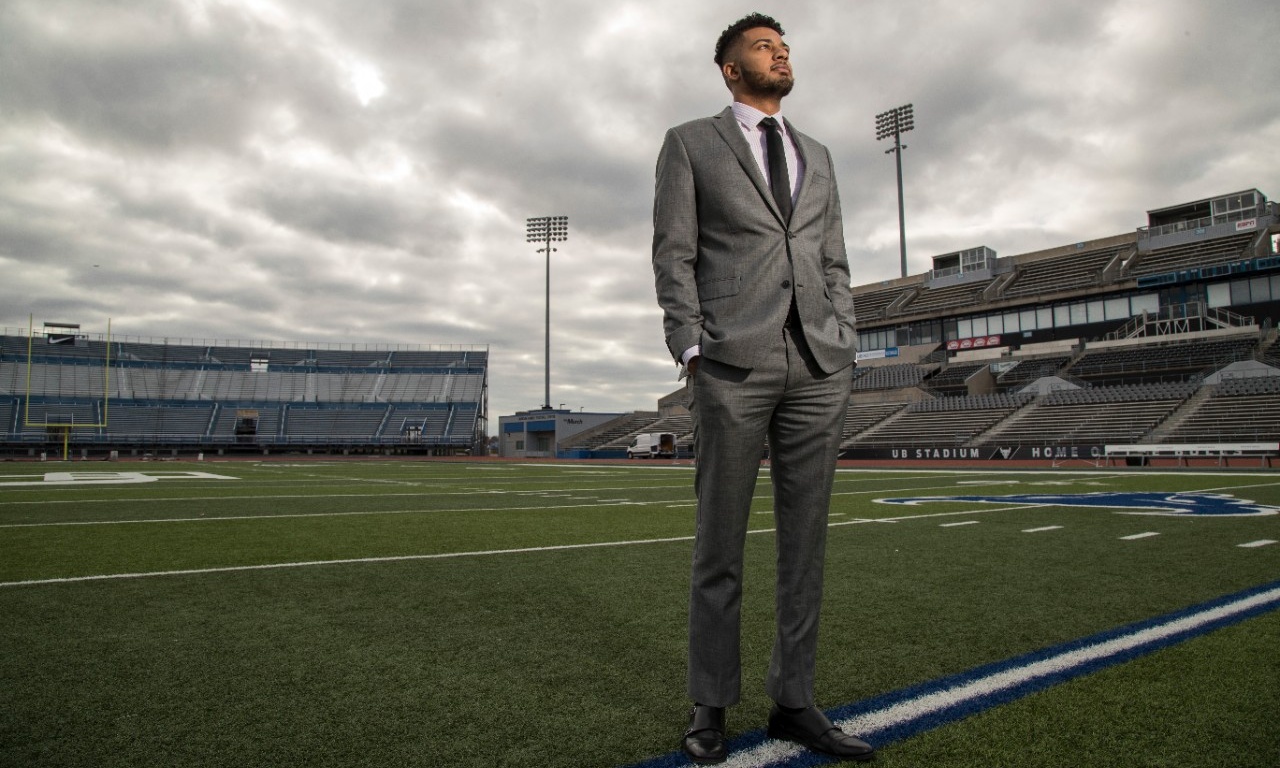Statistical solutions
Working closely with faculty, undergrads complete data-driven projects
By Matthew Biddle

Jake Cercone, BS ’18. Photo: Tom Wolf
Jake Cercone’s ‘Aha!’ moment came at 2 o’clock in the morning.
The management student was researching and developing a better measure for NFL quarterback performance than the commonly used passer rating, which only predicts a win 30 percent of the time. Cercone realized he needed to account for more than yards gained or interceptions thrown — his rating should calculate the opportunity cost of passes based on points scored or potential points lost through interceptions.
The passer efficiency score he created predicts wins 63 percent of the time.
By combining a sport he loves with statistics, Cercone gained hands-on practice with software like Excel, Tableau and IBM Watson, and leveraged that experience to land an internship with Pegula Sports and Entertainment.
“I learned how to scrape the data, determine what’s relevant and provide useful analysis,” says Cercone, who graduated in December and plans to return to UB to earn a JD/MBA. “Those are skills that can apply to any business situation.”
A key component of the School of Management’s undergraduate programs is the opportunity for students to complete real-world projects by engaging with area organizations, conducting independent research and even working with faculty on their research. Through those experiences, students gain experience with data analytics — critical for success in business.
“Data is everywhere, and data analytics is huge,” says Dianna Cichocki, clinical assistant professor of management science and systems, who co-advised Cercone on his project with faculty member Laura Amo. “Effective managers must be able to turn data into meaningful visuals and communicate that story. Those are key lessons students learn through projects like Jake’s.”

From left, Andrew Meyer, Megan Gramza, Professor Dianna Cichocki, Gabriel Gee and Pengbo Ma look over the team’s final deliverable for the Olmsted Center for Sight. Photo: Tom Wolf
In her business analytics class, Cichocki gives undergrads the chance to consult with organizations on data-driven projects, partnering last year with the nonprofit Olmsted Center for Sight and this semester with GEICO.
For one project, a team of five students took data from Olmsted’s 2-1-1WNY call center and extracted insights to inform staffing, training and other decisions. As their final deliverable, the team created a simple menu staff could use to see current trends and analyze data going forward.
“With the tools the students provided, we can point to data to say why our funders’ investment will have a positive impact on our service delivery,” says Kelly Dodd, director of contact center services at Olmsted.
Beyond technical skills, the students improved their critical-thinking and problem-solving abilities.
“It was important to track call times by type because every situation is different and an overall average wouldn’t tell the whole story,” says accounting senior Megan Gramza, who plans to earn her master’s at UB and has already secured a position with Andersen Tax. “This project taught me to go beyond the numbers and find the why.”

Michael Leung and Professor Dominik Roesch look over the undergrad’s stock trading strategy research. Photo: Tom Wolf
Michael Leung, a business student in the school’s Undergraduate Honors Program, has completed two semesters of independent research projects that ultimately changed his career goals.
With Dominik Roesch, assistant professor of finance, Leung examined all stocks traded on the New York Stock Exchange for a 10-year period to evaluate a strategy of buying stocks with the lowest overnight returns and short selling those with the highest. He further honed his programming skills working with Cristian Tiu, associate professor and chair of the Finance Department, on Tiu’s research exploring the trading of real estate investment trust options.
“Before these projects, I didn’t realize the sheer amount of data in existence and the insights we can draw from it,” Leung says. “Now I hope to work in a data-focused role and eventually move into artificial intelligence to do work that makes an impact.”
Sounds like another ‘Aha!’ moment.
Further research management undergrads conducted recently:
The cost of credit
Guided by faculty advisor Laura Amo, Zachary Richheimer analyzed the performance of loans issued by a peer-to-peer lending platform in Estonia. He created a model to predict loans with the highest probability of repayment and compared the premiums Estonian borrowers paid to Americans on another platform. “The project was a good exercise to evaluate global investment opportunities,” says Richheimer, BS ’17, product manager at NSR Invest.
SEO ethics
Ramzi Ganou worked with faculty advisor David Murray to research the risks of unethical search engine optimization practices, like hidden keywords. “I’d like to work for a technology-based company,” says Ganou, an honors student in accounting and computer science. “This gave me more insight into how technology can enhance businesses.”
Accounting for goodwill
With guidance from faculty advisor Jing Chen, accounting seniors Gyunbeom (Tom) Park and Luuly Park completed a literature review to evaluate the effect of 2001 guidance from the Financial Accounting Standards Board on the reporting of acquired goodwill and intangible assets. The pair, who will begin the accounting master’s program this fall, gained in-depth experience with accounting standards and research methods.
Narcissism in teams
Luuly Park added more skills when she worked with professors Timothy Maynes and Emily Grijalva on their research to assess the impact of individual team members’ narcissism on overall team functioning. Park combed through 12,000 tweets to score every NBA player’s narcissism level. “The knowledge I gained can be applied to any team setting,” she says.